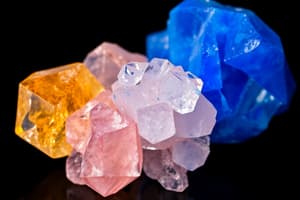Podcast
Questions and Answers
What defines the structure of crystalline solids?
What defines the structure of crystalline solids?
- They are isotropic in nature.
- They flow easily under pressure.
- They have a disordered arrangement of particles.
- They have an ordered arrangement of particles. (correct)
Which of the following is NOT a property of amorphous solids?
Which of the following is NOT a property of amorphous solids?
- They have a specific melting point. (correct)
- They flow under pressure.
- They often exhibit irregular fracture patterns.
- They lack an ordered arrangement of particles.
How do the properties of amorphous solids differ from crystalline solids?
How do the properties of amorphous solids differ from crystalline solids?
- Crystalline solids lack electrical conductivity.
- Amorphous solids are isotropic while crystalline solids are anisotropic. (correct)
- Amorphous solids have a fixed shape.
- Amorphous solids typically exhibit regular fracture patterns.
What is an example of an amorphous solid?
What is an example of an amorphous solid?
What phenomenon describes some amorphous solids remaining in a liquid state at temperatures below their freezing point?
What phenomenon describes some amorphous solids remaining in a liquid state at temperatures below their freezing point?
Flashcards
Solid
Solid
A state of matter with a definite shape and volume, due to particles held together by forces and arranged in specific positions.
Crystalline Solid
Crystalline Solid
A solid with an ordered arrangement of particles, resulting in varied properties depending on the direction of the particles.
Amorphous Solid
Amorphous Solid
A solid with a disordered arrangement of particles, resulting in isotropic properties and lacking a specific melting point.
Isotropic
Isotropic
Signup and view all the flashcards
Liquid Overcooling
Liquid Overcooling
Signup and view all the flashcards




